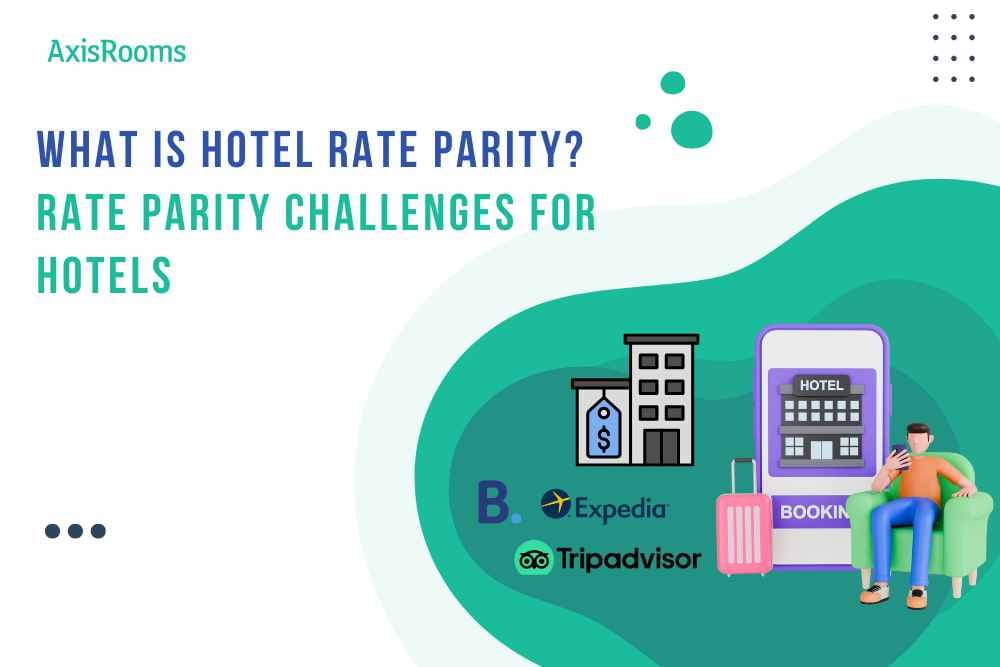Hotel rate parity is a crucial aspect of the hotel industry, ensuring consistent room rates are pushed and published across all distribution channels. This practice is essential for maintaining fair competition and protecting the hotel's brand integrity. However, achieving and maintaining rate parity comes with challenges and complexities that hoteliers must navigate.
Hotel Rate Parity Definition
Hotel rate parity refers to maintaining uniform room rates for a hotel across all distribution channels, including the hotel's official website, online travel agencies (OTAs), and other third-party booking platforms. It ensures that customers are presented with uniform pricing, irrespective of the platform they use to make a reservation.
Hotel Rate Parity Types
Hotel rate parity refers to the conditions of an agreement between a hotel and online travel agencies (OTAs) regarding pricing and availability. There are two types of rate parity - wide and narrow.
Wide rate parity is the stricter type, requiring the hotel to always offer the best room prices and availability to the OTA partner without allowing cheaper deals on any channel, including the hotel's website.
Narrow rate parity is less rigid, allowing the hotel to offer more favorable prices on other OTAs as long as the rate displayed on the contracted OTA is not higher than the hotel's website.
A hotel can offer discounts and perks to loyalty program members in both types.
Importance and Benefits of Rate Parity in the Hotel Industry
Rate parity ensures fair competition among distribution channels and safeguards the hotel's brand value. Hotels can avoid price discrepancies that confuse or frustrate potential guests by maintaining consistent pricing. Additionally, rate parity fosters customer trust and loyalty, creating a sense of fairness and transparency in pricing.
Hotel Rate Parity Leads to More Direct Bookings
Yes, that's right. Maintaining rate parity is a crucial objective for hoteliers as it incentivizes customers to make direct bookings through the hotel's website. Customers who see uniform prices across all channels prefer booking through the hotel's website if it provides a seamless booking process or additional perks. To promote direct bookings, hoteliers can offer special incentives to guests who book directly through the hotel's website. The best part is this - direct bookings yield higher profit margins than those made through online travel agencies (OTAs), consequently boosting the hotel's overall revenue.
Rate parity challenges for hotel
Despite its significance, maintaining rate parity poses several challenges for hotels. One major hurdle is the diverse distribution channels, each with its own pricing and commission structures. Additionally, fluctuating demand, dynamic pricing models, and currency exchange fluctuations further complicate ensuring rate or price parity.
Hotel Rate Parity Checker
Rate parity challenges for hotels are indeed complex, but tools are available to help address this issue. One such tool is a hotel rate parity checker. It allows hoteliers to monitor rates across various distribution channels in real-time. By leveraging this advanced tool, hoteliers can effectively identify disparities and swiftly take corrective action. With the help of a rate parity checker, hoteliers can streamline their pricing strategies and ensure consistency across all channels, ultimately enhancing their overall revenue management efforts.
Explaining Hotel Rate Parity Clauses
Some distribution channels impose rate parity clauses, which require hotels to offer the same or lower rates as those available on other platforms. While these clauses aim to create a level playing field, they limit the hotel's flexibility in setting prices and promotions. Hoteliers must carefully evaluate and negotiate these clauses to ensure they align with their overall revenue management objectives.
Hotel Rate Parity Clauses: Are Hotels Legally Bound to Follow them?
Hotels maintain rate parity through agreements with their distribution partners, often including rate parity clauses. These clauses mandate that the hotel's rates across all distribution channels be the same or higher than those offered on the hotel's website. Breaching this agreement by providing lower rates on a specific channel could result in the hotel violating its contracts and potentially losing access to that channel.
The legality of rate parity has been a topic of contention in certain regions. In the European Union, rate parity clauses were declared anti-competitive and subsequently prohibited in 2015. In the United States, rate parity is generally permissible, although some states have enacted legislation to prevent rate parity clauses in contracts between hotels and online travel agencies (OTAs). In 2022, India directed the two major OTAs - MakeMyTrip and Goibibo, to eliminate price parity and exclusivity obligations from their agreements with hotels.
Why are Hotels Against Rate Parity?
While rate parity serves essential purposes, many hotels have voiced concerns about its potential drawbacks. The restrictions imposed by rate parity clauses can limit a hotel's ability to offer personalized promotions and discounts, hindering its competitive edge. Additionally, the growing influence of OTAs and online platforms in setting pricing standards has raised debates about the fairness and practicality of rate parity.
Ensure Hotel Rate Parity with AxisRooms Channel Manager
AxisRooms Channel Manager allows you to instantly push the most up-to-date room rates and availability to your connected OTAs. For example, AxisRooms connects you to all leading OTAs, including Booking.com, Agoda, Go-MMT, etc., and updates your hotel's live rates in real time. It saves your time and eliminates errors.


